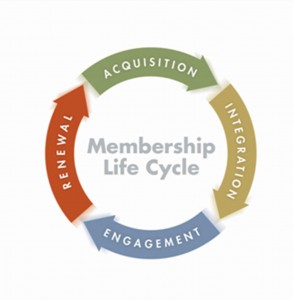Membership-based organizations spend a great deal of time in the Membership Life Cycle starting from the Acquisition Stage all the way through the last stage of Renewal. Let’s explore the Acquisition Stage, the typical challenges experienced, and the best practices to implement to in this critical first stage.
Stage 1: Acquisition of New Members
Successful acquisition or recruitment of new members requires a commitment to consistently market the organization’s brand to communicate who it is and what it offers to members, and to create an awareness and interest for prospects to join. The greater the awareness and positive brand recognition your organization has among the constituents you serve, the higher likelihood of prospects joining on their own or being receptive to marketing initiatives.
The most common challenges membership-based organizations face include:
- Lack of resources including time, staff, or funds to market consistently across all mediums (e.g. direct mail, web site, social media, trade shows, and community presentations).
- Inconsistent branding due to ineffective marketing initiatives, conflicting messages, or poor reputation.
- One-size-fits-all value propositions that don’t resonate with prospects.
- No sense of urgency for prospects to join.
- Perception of a lack of value for membership.
Best Practices for Stage 1: Acquisition of New Members
Recruit for retention.
- Recognize your target market — Not all prospects should be members, and the more narrow or specific you make your target market, the more accessible and receptive those prospects will be to joining the organization.
- Identify Ideal Members — Know the specific variables of members who are more likely to stay and value the benefits of membership (e.g. length of time in business or in the industry, size of organization, and common interests).
Maintain and implement a consistent marketing communication plan.
- External Plan — For various constituency groups you represent and the media that communicates the organization, unique value proposition, its strategic direction and accomplishments.
- Internal Plan — For members that do the same as above to keep them abreast of the organization’s direction and outcomes (don’t assume they know what you’re doing).
Manage a positive brand identity proactively and reactively.
- Audit Your Brand Identity Periodically — Get a pulse on the image and perceptions of the organization through surveys, focus groups, and interviews to ensure that communication plans are interpreted as planned.
- Manage Poor or Ineffective Brand Interactions — Respond to incidents or misperceptions as quickly as possible to correct, inform, or educate constituents on organizational perspectives or intentions.
Leverage effective value-propositions focused on benefits, not features.
- Features are the “what” and benefits are the outcomes or “WIIFM” (What’s in it for Me?) — For example, networking events are features and new lead generation, exposure or ales are the specific tangible outcomes of networking. Benefits should be communicated by language familiar to the prospects and not ours.
- General Value Propositions — Promote the values or benefits all members receive from the organization stated in language understood by all constituents. For example, instead of stating that you focus on “economic development,” explain how you help create a strong local economy. Economic development is our language and not necessarily understood by everyone.
- Unique Value Propositions — Promote the values or benefits specific members receive in a language that mirrors how the constituents communicate or what really matters to them. UVP messages may be different from group to group to be interpreted and received effectively.
Offer special promotions or incentives to join.
- Different Prospects, Different Needs — Create different promotions to attract new prospects based on their interests or needs such as free admission to an event, advertising opportunity, or a first-year or multiple-year membership discount.
Provide incentives to current members to recruit new members.
- Birds of a Feather Flock Together — Many great, current members will recruit other associates with similar values which create stronger communities and these prospects are more likely to stay with common established relationships in place.
- Bottom-Line Mindsets Create Self-Gratification Behaviors — Offer a reward or incentive for current members to recruit new members (e.g. credit toward a program or a discount toward their own membership dues). Of course, this can create the wrong reasons for recruiting prospects and should be managed appropriately.

Your article is full of useful information. Thank you, Cathi!
Very well thought our and written article Cathi.
An organization would be well served by having a meeting to go over your list every quarter, or so, and ask themselves how they are doing at each point.
Frank